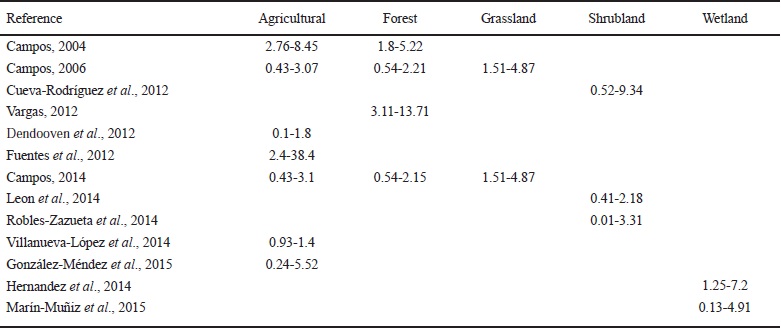Introduction
Soil respiration (RS, also known as soil CO2 efflux) is the second largest carbon (C) flux between terrestrial ecosystem and the atmosphere (Raich and Schlesinger 1992; Bond-Lamberty and Thomson 2010). Globally, it exceeds the input of carbon dioxide (CO2) by anthropogenic fossil fuels combustion to the atmosphere by an order of magnitude (Reichstein and Beer, 2008). Then, the importance of understand the dynamics and controls of RS is that it represents a net loss of C from the soils (Lal, 2004), and even a small change in this pool could represent a significant feedback to the Earth system (Reichstein et al., 2003).
There is a growing community across the globe interested in measuring and understanding soil C fluxes. Furthermore, there are growing databases for ecosystem CO2 fluxes (e.g., FLUXNET, AmeriFlux, MexFlux) (Baldocchi et al., 2001; Vargas et al., 2013) and RS (Bond-Lamberty and Thomson, 2014). However, most of the studies had been carried out in Europe and the United States (Bond-Lamberty and Thomson, 2010) at latitudes above 30° N. Ecosystems in those regions are characterized by temperate climates, with mean annual temperatures between 5-17 °C and annual rainfall above 600 mm; in contrast, arid, semiarid, tropical, and subtropical regions have been poorly represented, denoting that more tropical countries are underrepresented in continental-to-global understanding of the C cycle (Vargas et al., 2012).This bias has regional, continental, and global implications, from scientific understanding to policy making and management that could be reduced if more spatially refined and equally distributed estimations and measurements exists, to improve our knowledge of the factors that govern RS across time and space (King et al., 2015).
Mexico has many contrasting ecosystems, spanning from arid deserts to evergreen and tropical forest. Besides, Mexico exhibits heterogeneous landscapes due to land use change, mainly from deforestation, and livestock grassing (Vargas et al., 2012). Furthermore, Mexico is prone to natural hidrometeorological disturbances, such as the North American Monsson across the Pacific Ocean, and tropical cyclones occurring in the Caribbean and the Gulf of Mexico. Despite the great opportunity describe natural phenomena in contrasting gradients (e.g., altitudinal, disturbances) and the potential for manipulative experiments, Mexican scientists have barely studied the dynamics of RS and other ecosystem C fluxes (Escobar et al., 2008).
The main objective of this paper is to highlight the opportunities that scientists interested in RS (e.g., biologists, ecologists, soil scientists, hydrologists, modelers) have to advance on the knowledge of soil C cycle science. We first review the global literature of RS in order to give a brief description of the main mechanisms that controls RS, as well as common methodologies to measure it. Then, we make a synthesis from RS studies held in Mexico, to discuss the state of the art in this topic in the country. For the latter, we only focused on published literature where fluxes where measured or sampled in the field, excluding studies where soil samples were incubated in the laboratory.
Mechanisms
Soil respiration (RS) is a composite of two main CO2 sources (Ryan and Law, 2005): i) autotrophic respiration, the respiration by roots and mycorrhizae, and ii) heterotrophic respiration, the respiration of microorganisms within the soil that decompose fractions of organic matter plus the respiration of soil fauna. In view of the latter, RS exhibits complex dynamics across different spatio-temporal scales (Vargas et al., 2010b). The main abiotic controls of RS are soil temperature (Lloyd and Taylor, 1994; Davidson and Janssens, 2006) and soil moisture (Kim et al., 2012), while soil physical characteristics (Pumpanen et al., 2003) and organic matter inputs (Curiel Yuste et al., 2007) influence the composition of soil biota (Nannipieri et al., 2003). Although RS is the main CO2 efflux from the soil to the atmosphere, other non-biological processes contributes to CO2 emissions (Rey, 2015). An example of the latter is the chemical weathering of calcium carbonate (Ca CO3) (Serrano-Ortiz et al., 2010; Hamerlynck et al., 2013) and pore degassing following major inputs of water (Liu et al., 2002; Lee et al., 2004).
Biophysical controls
At different spatial scales (e.g., plot to continental), soil temperature and soil moisture have been considered the main abiotic factors that account for the major temporal variability of RS (Subke and Bahn, 2010). Although the temperature dependence of RS has been greatly studied, there is still an open discussion about the temperature sensitivity of soil organic matter (SOM) decomposition (Giardina and Ryan, 2000; Davidson and Janssens, 2006; Conant et al., 2011), and the dependence of RS on soil moisture is not well understood (Moyano et al., 2012; Vicca et al., 2014). Furthermore, studies in the last two decades have demonstrated that photosynthesis plays also a key role regulating RS (Högberg et al., 2001; Vargas et al., 2011). Thus, the interactions among these factors across temporal scales cause great uncertainties in estimations of RS, and it becomes difficult to extrapolate site measurements to the estimation of C budgets at different spatial scales.
Temperature
In most of the global literature, the variation of RS has been treated as a function of soil temperature (Lloyd and Taylor, 1994), the most widely used equations being those of van’t Hoff and Arrhenius (Sierra et al., 2011). The temperature dependence of RS reflects the effect of temperature on microbial metabolism which is derived from enzymatic kinetics (Schipper et al., 2014). This temperature dependence of RS had received much attention in recent years due to contradictory results (von Lützow and Kögel-Knabner, 2009) resulting from different methods, such as incubation experiments, field measurements (Rinkes et al., 2013), different substrate pools [ e.g., high-quality-labile-fresh or low-quality-recalcitrant-old (Van Hees et al., 2005) ], different metabolic temperature sensitivities of autotrophic or heterotrophic components (Boone et al., 1998), or different indices or empirical relations used to describe this relationship (Sierra, 2012). An important factor is the heterogeneity of abiotic and biotic factors within the soil profile (texture, temperature, moisture, microorganism composition, life strategies, acclimatization delays, root composition and distribution).
In temperate ecosystems, the diurnal increase and decrease of soil temperature is generally reflected in RS (Xu and Qi, 2001; Subke et al., 2003). Some researchers have observed diel hysteresis and two arguments have been proposed to explain this phenomenon: i) environmental variables such as photosynthate production, litterfall, and soil organic carbon (SOC) availability may oscillate out of phase with soil temperature (Carbone et al., 2008; Vargas and Allen, 2008a); ii) soil temperature is measured at a fixed depth but CO2 efflux represents a profile, leading to differences in magnitude and phase (Lasslop et al., 2012). Of course, CO2 production has an intrinsic lag with surface efflux, dependent on depth and diffusion (Vargas et al., 2010a). The temperature response of RS has concerned the scientific community because climate change would lead to positive feedback of CO2 emission to the atmosphere (Fang and Moncrieff, 2001).
Moisture
Microbial decomposition as well as root respiration may be limited by water availability. Global patterns of precipitation are changing in terms of number of events, event size, and the number of dry days between events (Knapp et al., 2015). However, the response of RS to precipitation events, or soil moisture, is relatively unknown (Kim et al., 2012).
For these reason researches had proposed several explanations and hypothesis of what could be happening after rain events: i) a rapid degasification of soil air-filled pore spaces (Yépez and Williams, 2009), ii) a re-hydration of dormant fungi and microbes and an increase of their biomass (Chowdhury et al., 2011), iii) microbial cell lysis due to a osmotic shock (Van Gestel et al., 1992), iv) release of microbial osmolytes that may support broader increases in metabolism (metabolic hypothesis) (Xiang et al., 2008), v) rewetting of old, non-available or recalcitrant compounds (physical hypothesis or priming effect) (Kuzyakov, 2010). Also, root respiration should affected by the return of moist conditions. Ecosystems with highly seasonal hydrology are common in Mexico, so soil moisture is likely to be a key limiting factor in many processes controlling RS in Mexican ecosystems.
Mexico has a coastline of 12 122 km, where other non-rainfall inputs of water could influence the C exchange from terrestrial ecosystems to the atmosphere. Reimer et al. (2015) found that sea surface temperature could influence gross primary productivity (GPP) trough fog formation in the Baja California Peninsula; fog is an important non-rainfall water input in tropical cloud forests in Veracruz, as well in the deserts across Baja California, but it has not being linked with RS yet. Carbone et al. (2011) found in the Santa Cruz Island in California that seasonal and episodic moisture inputs from fog can influence the magnitude of RS. Thus, it is important to recognize that not only water inputs from precipitation triggers RS, but other non-rainfall inputs, such as dew or fog could influence RS.
Photosynthesis
Although temperature and moisture are the main temporal controls of RS, recent studies provide evidence that plant photosynthesis influence RS at different temporal scales, challenging the assumption that most of the soil CO2 efflux is microbial-derived (Kuzyakov and Gavrichkova, 2010; Mencuccini and Hölttä, 2010; Brüggemann et al., 2011; Vargas et al., 2011). For example, there is evidence that >60% of the C released by RS in a temperate forest could be related to recent photo-assimilates transported belowground (Taneva et al., 2006), and root respiration could be insensitive to decreasing temperatures while microbial metabolism is inhibited (Singh et al., 2003).
This relationship of RS with photosynthesis showed temporal lags and phase differences from hours to days. However, these relations depend on ecosystem type, as well as vegetation phenology. For example, Vargas et al. (2011) showed that different forest types (e.g., Mediterranean, temperate, boreal) could present the same temporal lag between photosynthesis and RS (i.e., one day) but the duration (in days) of the effect differed. In contrast, grasslands used photoassimilates produced the same day for root respiration (Tang et al., 2005; Bahn et al., 2009).
Temporal variation
Seasonal variation of RS has been observed in almost every ecosystem. This variation is driven by seasonality of temperature, light, soil moisture, and the derived growing seasons of the vegetation and soil biota. This variation can be explained by leaf area index (LAI), litter production and root biomass (Thomas et al., 2000). Phenology plays a key role, mainly through the timing of litterfall, labile C fraction availability, and root turnover (Curiel Yuste et al., 2004). In special cases like wetlands, the main factor controlling RS is the tidal fluctuation where spring-neap tide cycles results in a fluctuating soil O2 concentration, which limits or enhances both microbial and root activity and thus RS (Lovelock, 2008).
Successional changes in an ecosystem also drive variability of RS during long-time scales (Chapin et al., 2002). During secondary succession, RS may rise substantially because some disturbances (e.g., logging, hurricanes, floods, but not f ire) may input large amounts of labile C into the soil (Vargas, 2012a). This enhancement of RS eventually subsides (Luo and Zhou, 2006). In late succession, RS is expected to be high due to litter production and accumulation, and root density (Kolari et al., 2004; Luo and Zhou, 2006, Kopittke et al., 2013).
Spatial variation
Soil properties and dynamics are vertically and horizontally heterogeneous across the landscape, changing within a few centimeters (Figure 1). Soil texture and tortuosity affect the diffusion rate of the gases within the soil (Moldrup et al., 2001). The local availability of nutrients affects soil microbiota composition and activity, influencing RS rates (Lipson et al., 2005; Almagro et al., 2013). Soil temperature and moisture are spatially heterogeneous (Huxman et al., 2004), creating spots where the metabolic activity of microbes and fine roots are higher or lower (Jenerette et al., 2008) producing hot spots and hot moments of RS across the landscape (Leon et al., 2014). Special attention has been paid to the effect of vegetation on RS. For example, Barron-Gafford et al. (2011) studied the dynamics of RS under different cover types (under grasses or mesquites, and inter-canopy), Tang and Baldocchi (2005) evaluated the influence of the proximity of trees on RS, Cable et al. (2011) compared RS in seven different deserts, and Rochette et al. (1991) evaluated the influence of different crops on the efflux of CO2 from the soil.
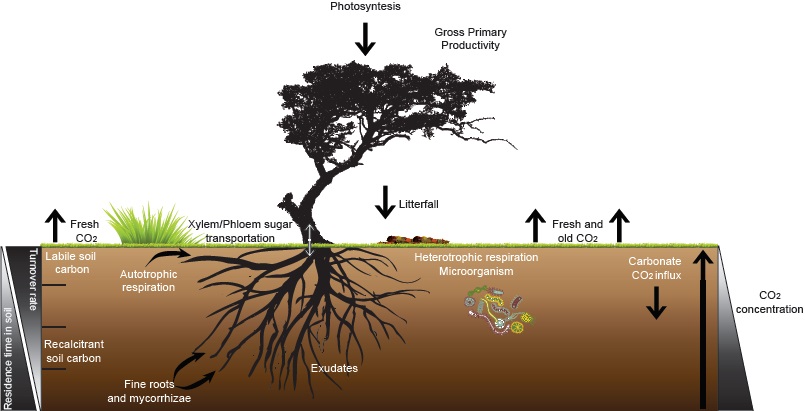
Figure 1 Schematic representation of the main components of soil respiration. Autotrophic respiration is mainly controlled by carbon allocation by the xylem/phloem transport, meanwhile heterotrophic respiration is controlled by substrate availability; however, both fluxes are temperature and moisture dependent. The scales on the sides represent a gradient, being darker the highest and clearer the lowest. This figure was recreated after the conceptual models of Ryan and Law 2005; Kuzyakov and Gavrichkova, 2010; Brüggemann et al., 2011. Figure produced by Lluvia B. Vargas-Gastélum.
Methods and techniques to measure and estimate soil respiration
There are different approaches to measure RS in the field (Figure 2): i) CO2 trapping, ii) measurement of surface concentration changes, and iii) measurement of CO2 along soil profiles. These techniques had been widely used elsewhere but seldom in Mexico. Here we briefly describe their operational principles. The first two are typically used with a ring inserted several centimeters into the ground and projecting above the surface, defining both a surface and its lower entry, installed some weeks in advance of measurements to allow acclimation of the soil system to the disturbance.
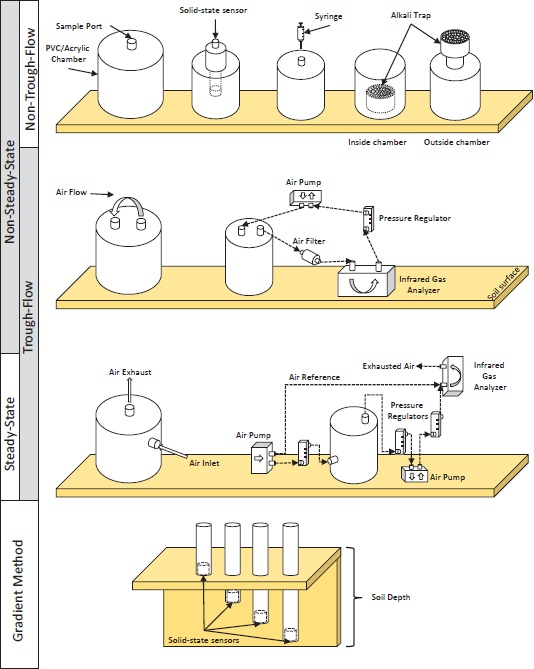
Figure 2 Schematic representation of the different methods and techniques to measure and estimate soil respiration. See Section 3 for further explanation. Figure based on Livingston and Hutchinson, 1995; Luo and Zhou, 2006; Vargas and Allen, 2008c; Risk et al., 2011; Cueva-Rodríguez et al., 2012.
The trapping technique consists of placing a chamber hermetically in the soil ring, collecting air or CO2 after some time interval for further analysis in the lab. Collecting devices are typically syringes or alkali. With syringes, the CO2 concentration is measured using a gas chromatograph; for the alkali trap, CO2 is measured by simple chemical procedures.
For estimation from the rate of change of CO2 concentration, a chamber placed on the soil ring, attached to an Infra-Red Gas Analyzer (IRGA), air is circulated actively or passively in the system and CO2 concentration is measured repeatedly (for a few minutes) through its adsorption of specific bands of light (Cueva-Rodríguez et al., 2012).
The gradient method is based on the Fick’s law of diffusion and consists of measuring CO2 concentrations at several depths in the soil profile with solid-state non-dispersive infrared CO2 sensors (De Jong and Schappert 1972; Tang et al., 2003; Maier and Schack-Kirchner, 2014). Measurements are made often over weeks or months (after acclimation to the installation).
These methods have errors, both systematic (Davidson et al., 2002; Pumpanen et al., 2004) and random (Savage et al., 2008; Cueva et al., 2015), but the former are relatively well-studied (Simunek and Suarez, 1993; Fang and Moncrieff, 1996; Janssens et al., 2000; Rayment, 2000; Davidson et al., 2002; Pumpanen et al., 2003, 2004; Pingintha et al., 2010; Heinemeyer et al., 2011; Maier and Schack-Kirchner, 2014). While systematic errors are related to improper calibration, instrument malfunction, or mistakes in data handling, random errors are caused by unknown and unpredictable sources (Cueva et al., 2015).
Soil respiration in Mexico
While gas emissions from soils have been measured since almost 90 years ago (Lundegårdh, 1927), the first measurements of soil gas exchange published in peer review literature from Mexico were in the early 90s, (Davidson et al., 1991, 1993; García-Méndez et al., 1991). The first measurements of soil CO2 efflux were reported in 2004 (Table 1). Most of the research on RS in Mexico had been carried out in agroecosystems, followed by forests, shrublands, grasslands, and wetlands (Table 1). The most common method to estimate soil gas emissions had been the syringe method, followed by the IRGA-based (closed system) method, and least-used have been the alkali and gradient methods. It must be emphasized that most of the studies have focused on spatial variation or the effect of a treatment, and few studies had been about the temporal variation of RS.
Table 1 Soil respiration studies in Mexico.
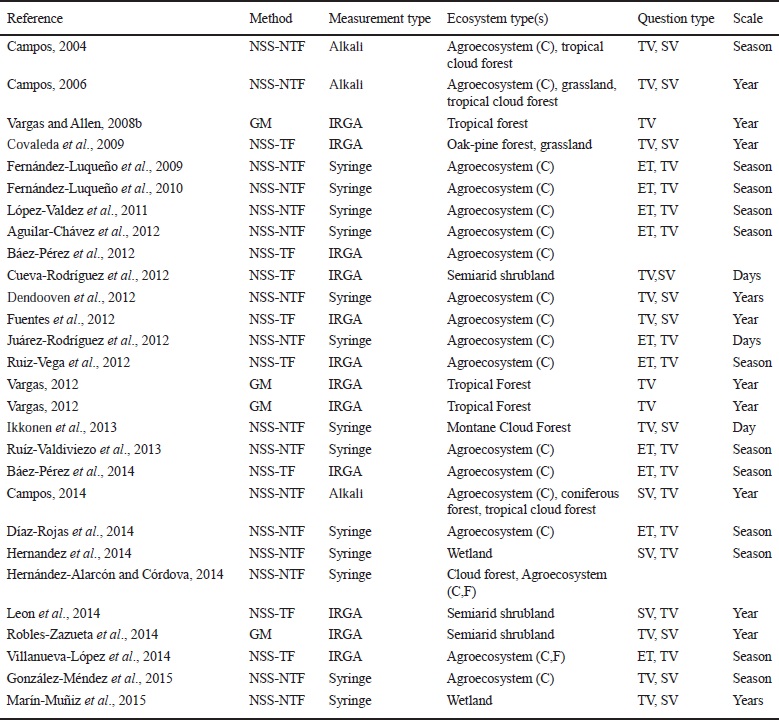
(N)SS = (Non-) Steady-State; (N) TF = (Non-) Trough-Flow; C = Cropland; F = Farmland; TV = Temporal Variation; SV = Spatial Variation; ET = Effect Treatment
The RS research in Mexico for agroecosystems have been focused on amending crops yields without increasing soil CO2 emissions. It is known that the conversion from natural to managed ecosystems (e.g., agroecosystems) causes depletion of SOC (Guo and Gifford, 2002), due to the alteration of the balance between C inputs (e.g., GPP, photosynthesis, litterfall) and outputs (e.g., RS, photodegradation) of (Kim and Kirschbaum, 2015). This type of research has been preponderant in Mexico, reflecting the high rate of land use change (Balbontín et al., 2009; Sánchez-Colón et al., 2009).
Changes in soil CO2 efflux have also been examined for different management practices in agricultural land. For example, the addition of fertilizers increased soil CO2 efflux in bean and maize cultivations (Fernández-Luqueño et al., 2009, 2010), but had no effect in a sunflower cultivation (López-Valdez et al., 2011). The addition of charcoal reduced CO2 emissions (Aguilar-Chávez et al., 2012). Contrasting results were found in comparison between conventional and conservational agricultural practices, such as no changes in either maize or wheat cultivations (Dendooven et al., 2012; Ruiz-Vega et al., 2012), but reduced emissions with the reduction of mechanical disturbance and the retention of crop residues after harvest (Fuentes et al., 2012). Despite of the negative, null or positive effect on RS, many of the latter studies coincide that SOC increased when fertilizers or charcoal (e.g., urea, waste water, biochar) were added, and where little or no disturbance was present (e.g., reduced or zero tillage).
The first RS study in México was conducted in a tropical cloud forest (Table 1). It is important to highlight that several of the studies in forest landscapes Mexico deal with the effects of land use changes, where RS increases while SOC decreases (Campos, 2004, 2006, 2014; Covaleda et al., 2009). It is also noteworthy that the highest RS rates reported globally was from a Mexican tropical deciduous forest in the Yucatan Peninsula, after perturbation occasioned by Hurricane Wilma (Table 2; Vargas and Allen, 2008b; Bond-Lamberty and Thomson, 2010). The influence of the hurricane enhanced RS due to plant defoliation (Vargas, 2012b). Thus, we highlight the importance of high-frequency (e.g., 30, 60 min) and also opportunistic measurements, to understand the effects of diurnal, seasonal, and inter-annual variations because they offer the opportunity to understand the effects of extreme events on ecosystem´s carbon fluxes.
Although almost half of the Mexican territory is arid or semiarid, only a few studies of RS had been carried out in these regions. Because ecosystems in these climates are characterized by patchy vegetation patterns, soil physical characteristics (e.g., moisture and temperature) that vary greatly across only a few meters. The complex spatio-temporal dynamics in soil processes can include ephemeral periods with very high RS rates (Table 2). For example, in a subtropical shrubland in Sonora, Robles-Zazueta et al. (2014) estimated RS under woody canopies and exposed patches (bare soil) over the growing season of 2012, finding evidence for a strong but differentiated control of precipitation pulses over RS during the rainy season. Although no explicit measurements were carried to explain the RS differences between the vegetated and the exposed patches, the larger RS fluxes following precipitation events in bare patches (Figure 3) are probably explained by rainfall not reaching the ground due to canopy interception in vegetated patches. On the same study site, Cueva-Rodríguez et al. (2012) found spatial differences in RS related to different plant species. Also in a mediterranean-climate shrubland in Baja California, Leon et al. (2014) found that RS increased by 522% after rewetting of the soil following the dry season but remained elevated during part of the growing season. Here, spatial variability was strong and best-related to local soil moisture and litter accumulation. These studies coincide that the main driver of RS was water availability, while soil temperature only extended an influence when water was present. It has recently demonstrated that arid and semiarid ecosystems play a key role on the global carbon cycle (Poulter et al., 2014), emphasizing the importance of studies that would propose alternative models to describe the functional controls on RS water limited ecosystems
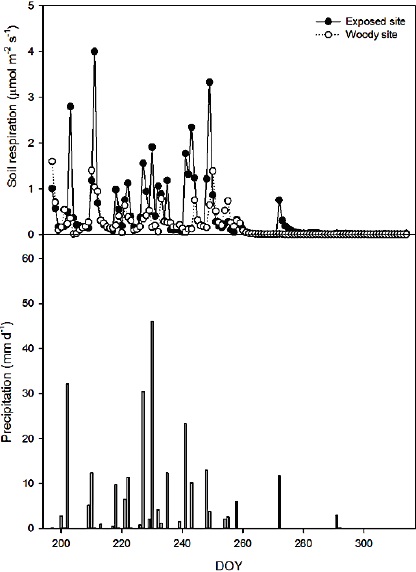
Figure 3 Seasonal variation of RS in a subtropical shrubland of Sonora. Estimates of RS were conducted with the gradient method during the rainy season of 2012 (Robles-Zazueta et al., 2014).
Hernández et al. (2014) measured CO2 emissions in freshwater wetlands and flooded grasslands in Veracruz. CO2 emissions were higher during the dry season and decreased during the rainy season, with rates similar to the windy season. In adjacent freshwater marshes and swamps Marín-Muñiz et al. (2015) measured RS during two years, over the dry, rainy and windy seasons. The highest rates of emission were measured during the dry season, followed by the rainy season, and the lowest rates during the windy season. Soil CO2 emissions from wetlands have been related to biological variables (SOC quality and availability, dissolved organic carbon (DOC); McLeod et al., 2011), as well as to physical variables such as dissolved oxygen, hydroperiod, temperature, salinity, electrical conductivity and pH (Alongi, 2014).
While most research on RS has been carried out in agroecosystems and forests, and many ecosystems have been poorly represented in Mexico some commonalities emerge across the available studies. For example, in most of the ecosystem presented in this manuscript RS could be coupled with soil temperature, as long as moisture is not a limiting factor. However, since most of the studies of RS in Mexico had been based in low frequency measurements, we cannot know which could be the threshold of soil moisture to become a limiting factor. Related to the latter, Kim et al. (2012) suggested the designs of manipulative experiments that could enhance our knowledge about the interaction of soil rewetting. Furthermore, also Kim et al. (2012) highlighted that most of the studies that explores the effect of soil moisture on RS are carried out on small spatial scales, and that is critical to scale up these interactions at ecosystem level.
Mexico is a country with high rates of land use change, mainly by deforestation and livestock grassing. Thus, intensive agricultural practices could enhance RS and deplete SOC pools, while conservation agricultural practices could decrease RS and increase the SOC. However, despite that most of the studies of RS in Mexico had been carried out in agroecosystems, few of them had compared the trade-off of converting natural to managed ecosystems.
Future directions of soil respiration research in Mexico
The Mexican Carbon Program (Programa Mexicano del Carbono; PMC) has developed databases and improved techniques and methodologies related to SOC stocks (Fuentes-Ponce et al., 2012), however, these stocks result from different processes, both aboveground (e.g., photosynthesis) and belowground (e.g., decomposition) that are not well described in Mexican ecosystems. For example, although in Mexico exists long-term observations of above-ground production and below-ground decomposition (e.g., Anaya et al., 2012), high-frequency measurements (e.g., every 30-60 min) are needed to understand short-term processes on an hourly-to-daily basis (Carbone and Vargas, 2008).
Most of the studies of C exchange between the ecosystems and the atmosphere in Mexico had been originated from individual efforts (Vargas et al., 2013), and it is reflected in the RS research in Mexico: few sites with various publications or many sites with one publication. Furthermore, most of the studies presented in this review do not meet the criteria to be included in global databases, being only the studies of Campos (2006) and Vargas and Allen (2008c) included on the Global Database of Soil Respiration Data (V 3.0, Bond-Lamberty and Thomson, 2014). This situation reflects that most of the studies of RS in Mexico had been conducted on short-term scales (e.g., days, weeks, and season), making a poor representation of the country in continental-to-global synthesis.
For these reasons, is preponderant to adopt knowledge from global experiences and develop expertise across the country to acquire long-term RS data and fulfill national needs to study the C cycle in Mexico. For example, methodologies should incorporate long-term high-and-low frequency measurement protocols, with criteria to study the spatial heterogeneity and a strategy to integrate high frequency measurements. Furthermore, it should be a priority for Mexican C cycle scientists to develop technologies that reduce costs to transfer these technologies from developed countries (i.e., Cueva-Rodríguez et al., 2012). Meanwhile, we need to develop a strategic plan to advance on the RS research in Mexico, as well as collaborative research groups.
It is noteworthy that none of the peer-reviewed studies of RS in Mexico has been carried out in a Mexican Long-Term Ecological-Research site (Mex‑LTER). Incorporating long-term measurements in Mex-LTER sites would offer a great variety of contrasting ecosystems with a natural altitudinal gradient, as well as an integrative framework between ecologists and social scientists (Maass et al., 2010). Thus, long-term RS studies in Mex-LTER sites could provide baseline information to identify the responses from ecosystems after low-but-constant or fast-and-rare disturbances (Turner et al., 2003). However, little has been done in Mexico about how disturbances affects functional processes in ecosystems (Calderon-Aguilera et al., 2012). For example, tropical cyclones and hurricanes are fast-and-rare natural disturbances that have a strong influence on terrestrial vegetation across Mexico (Farfán et al., 2014). Vargas (2012a) highlighted the importance of high-frequency measurements in a fast-and-rare disturbance, documenting the legacies of a hurricane on RS in the Yucatan Peninsula. However, if Vargas (2012a) had had only low-frequency measurements we would only know the status of the ecosystem before-and-after the hurricane, leading only to infer what happened during the hurricane.
MexFlux sites (Vargas et al., 2013) also offer an opportunity to carry out RS measurements across Mexican ecosystems. Since RS estimates at the represented ecosystems would be accompanied by estimates the net ecosystem exchange of matter (e.g., CO2, CH4) and energy (e.g., H2O) between the ecosystem and the atmosphere and combined efforts will allow more refined estimates of ecosystem fluxes by empirical models (e.g., Reichstein et al., 2005; Lasslop et al., 2010). Flux partitioning of different C fluxes within the ecosystem had been commonly compared with RS measurements as a proxy of ecosystem respiration. Moreover, data of RS in conjunction with net ecosystem exchange (NEE) measurements to estimate ecosystem respiration could provide insights for partitioning of ecosystem respiration on its, heterotrophic and autotrophic components, which reminds as a central question in C cycle research.
Thus, the future directions on RS research in Mexico should be:
a). Develop a base-line understanding of the biophysical controls of RS across different ecosystems in Mexico, including the responses when a land use change occurs,
b). establish long-term (>5 years) observatory networks to measure RS across different ecosystems and management schemes,
c). within the latter, establish manipulative experiments to obtain mechanistic knowledge of how different scenarios (e.g., increasing temperature or changing timing and magnitude of precipitation) could affect RS (Norby and Luo, 2004),
d). when an array of long-term measurements has been established, large-scale modelling of RS using satellite data could be carried out (i.e., Wu et al., 2014),
e). develop a Mexican database of RS records, with a quality assurance and quality control (QA/QC) protocols (Carbone and Vargas, 2008),
f). integrate aboveground phenological measurements and net fluxes (e.g., phenocams, Richardson et al., 2007; Vargas et al., 2013),
g). integrate belowground phenological measurements (e.g., minirhizotrons, (Hasselquist et al., 2009),
h). integrate emerging disciplines to explain patterns and mechanisms (e.g., ecological genomics, Escalante et al., 2014),
i). isolate autotrophic and heterotrophic respiration from total RS (Hanson et al., 2000),
j). integrate other greenhouse gases related to RS measurements (e.g., CH4, NO, NO2),
k). continuous interaction of universities, research centers, and government agencies, as well as with other networks (e.g., MexFlux, Mex-LTER).
Coupled with the lack of knowledge of RS in Mexican ecosystems, predicted and actual temperature changes across the country (Diffenbaugh et al., 2008; Tejeda-Martínez et al., 2008; Pavia et al., 2009; García-Cueto et al., 2010), as well as changes in precipitation patterns (Arriaga-Ramírez and Cavazos, 2010; Pérez-Morga et al., 2013) with less frequent but more intense precipitation events (Cavazos, 2012), longer and drier dry seasons, and increasing water stress across the country (Fuentes-Franco et al., 2015), urges the Mexican scientific community to increase its interest and efforts in studying ecosystem C fluxes. We believe that strong synergies could become fruitful if interdisciplinary research in this field is carried out. Concluding, this review should not be considered as a baseline of the knowledge on RS in Mexico, but it should be re-evaluated on the middle (e.g., 5 years) and long (e.g., 10 years) term to know what progresses had been made.











 nova página do texto(beta)
nova página do texto(beta)

